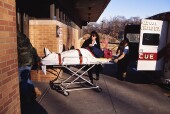
MONDAY, Feb. 8 (HealthDay News) — Older Americans who have strokes are getting better treatment, possibly because of a nationwide program encouraging use of guideline-recommended therapies, a new study shows.
“What we saw in the course of the study, the six years from 2003 to 2009, was remarkable improvement in treatment of all age groups,” said Dr. Gregg C. Fonarow, professor of cardiology at the University of California, Los Angeles, and lead author of a report published online Feb. 8 in advance of print publication Feb. 23 in Circulation.
“Because older patients started with lower treatment rates, they had even more dramatic improvement,” he said.
The study looked at age-related treatment of more than 500,000 people admitted to 1,256 hospitals for ischemic stroke, in which a blood clot blocks a blood vessel in the brain. Between 70 and 80 percent of all strokes are ischemic, Fonarow estimated.
Older people are more vulnerable to stroke damage. Each 10-year increase in age means a 31 percent reduction in the possibility of discharge home from a hospital and a 27 percent increase in the likelihood of death in the hospital, the study found.
But some hospitals had been reluctant to use aggressive therapy for older stroke patients because they feared side effects. One such side effect is excess bleeding tied to the use of a powerful clot-buster, called tissue-plasminogen activator (tPA), Fonarow said.
A program of the American Heart Association and the American Stroke Association, “Get With The Guidelines–Stroke,” promotes use of seven therapies for ischemic stroke, including the quick use of tPA to break up a clot.
“In all seven recommended measures, we saw substantial improvement over time in all age groups,” Fonarow said. “For tPA, treatment was started in 20 percent of patients over 90 before the program. That increased to 62 percent. The use of lipid-lowering medications to prevent recurrence increased from 15.6 percent to 71.7 percent of those patients.”
Similar improvements were seen in other performance measures, he said.
The hospitals in the study handle about 40 percent of all the ischemic strokes that occur in the United States, Fonarow said. Whether the same improvement in meeting treatment guidelines occurred in other hospitals is unknown, he said.
It’s also not possible to say whether the increased adherence to therapy guidelines resulted in better outcomes for those getting treatment, since the study was not designed to measure outcomes, Fonarow said. “We just followed patients to hospital discharge,” he said. “Additional studies after their release from hospital would be necessary to determine outcomes.”
But an improvement in outcomes might be expected, since some of the recommended therapies, such as long-term use of cholesterol-lowering drugs, are designed to prevent new strokes, Fonarow said.
Some other studies are looking at long-term outcomes of stroke treatment, he said. “We would like to see the remarkable improvement that occurred from 2003 to 2009 continue,” Fonarow said. “We will be looking at age-related differences in other kinds of strokes.”
An ongoing effort is under way to try to collect data on stroke treatment in hospitals not in the program, said Dr. Ralph Sacco, professor and chair of neurology at the University of Miami and president-elect of the American Heart Association.
“The American Heart Association has been a big proponent in generating state-supported systems of care, and there is an increasing proportion of the U.S. population that is in closer proximity to stroke centers,” Sacco said.
The “Get With The Guidelines” program “has been a tremendous success in improving evidence-based higher-quality care for acute stroke,” he said.
More information
Advances in stroke treatment are described by the American Heart Association.

